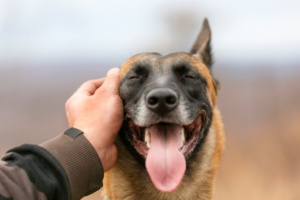Wean your dog off food reinforcement in training

Some dogs find praise and touch reinforcing.
Sometimes life puts you in situations in which you can’t reward your dog with food — you may not have treats on you, but your dog may have done something great. You may be tired of wearing a treat bag every time you take a walk, or you may have forgotten it. You may have put yourself into a situation in which you cannot use food — signed up for the Canine Good Citizen exam, or entered a dog event in which you may only reward with praise and petting.
Do you have to wean off food rewards?
Maybe not. Some people never do stop using food in training, and that’s ok. Their dogs live interesting lives and behave well. They are just as likely to get consistently good results as those who wean their dogs off food.
Also, some cues are so important you may decide you’d rather pay the dog well each time. Long distance recalls away from distractions like people, dogs, toys, and food fall in this category. If your dog leaves another dog at the dog park to come to you from 30 feet away, perhaps he deserves a piece of beef liver (or several).
Young puppies may need to stay on food rewards for months, with the exception of fully proofed day-to-day commands like Sit and Down. Dogs with behavior issues may always need food for therapeutic intervention when confronted with stimuli that upset them.
Walking on a leash without pulling is inherently rewarding — the reward is that the walk continues, so long as the leash is slack. After sessions in which the dog learns where heel position is (left or right side, close to the handler), treats may not be needed, especially if sniff breaks are built into the walk and used as rewards.
How to wean your dog off food reinforcement in training
* Give him a food reward every other time he gets it right (50% reinforcement). The other times, reward him with praise and petting. Make sure your praise and petting make him happy. Some dogs don’t like being touched, especially on top of the head or around the collar. Getting to chase a ball or play tug with you for a few seconds might being more fun for him than hearing you say “Good boy” or having you reach for his face.
* Check his accuracy rate. If you ask him to Sit 10 times in a row, does he get it right 90% of the time (the first time asked) at a 50% reinforcement rate? If so, you may start to vary the frequency with which he is reinforced — every third time, or fourth, or fifth, and so on. This option (a variable reinforcement schedule) may be the most potent rate of reinforcement of all.
If your dog’s accuracy rate dips below 90%, reintroduce food rewards, or change the treat you are giving him. Dogs appreciate novelty. Offer the occasional jackpot. A big reward — 5 or more treats, offered with speed and enthusiasm, may reinvigorate a dog working slowly or sloppily for praise or petting.
* Get treats off the body. Remove obvious signifiers of training and pending food reinforcement from your person — take off your treat bag or fanny pack, or swivel it around so it’s behind your back or clipped to your hip pocket instead of in front of your dog’s face. Hide a cache of treats within distance of where you are training. When your dog responds accurately to the cue, mark it (“Yes!”) and run together for the reward. This will help your dog understand that the food reward could be anywhere — or perhaps the reward lies in the run with you after he has responded correctly. Never underestimate the value of relationship and play as the most potent reward of all.
